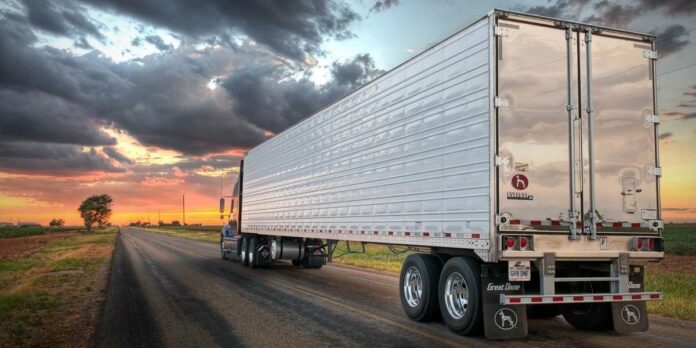[ad_1]

Great Dane says to expect more focus on trailer and refrigeration unit electrification.
Photo: Great Dane
There’s no doubt that an ongoing, and accelerating, technology wave has been overtaking trucking. But despite the seemingly daily onslaught of new technologies transforming virtually every aspect of the industry, there is a sense that trailers are somehow lagging behind.
Granted, the bulk of new transportation technologies emerging are clearly focused on the power unit side of the tractor-trailer equation. And it only makes sense to perfect systems such as telematics, alternative fuels and powertrains, safety systems, autonomous control systems, and “smart,” self-learning components on a truck or tractor before further integrating those systems into the trailer behind it.
But sooner, rather than later, this technology wave will sweep trailers up in its path, too. One need only look at the news from Swedish electric/autonomous truck (and now trailer) startup Einride for a glimpse at where technology will soon take trailers.
In the meantime, trailer makers are actively pursuing and developing their own technology curves, often working with third-party tech and telematics providers. For instance, Hyundai Translead last fall announced its HT LinkSense, an open-platform smart trailer solution that is fully integrated with leading telematics partners. Another example: Earlier this year, Wabash launched a new technology alliance with Clarience Technologies focused on trailer applications, including new advanced connectivity applications the companies said will be essential as electric and autonomous vehicles come to market.
And speaking of electrification, look for more focus on trailer and refrigeration unit electrification, according to Great Dane.
Great Dane Electrification Product Manager Colby White believes it won’t be long for all-electric TRUs to become more commonplace in the transportation industry. With fuel prices on the rise and not expected to drop any time soon, he says in an article on Great Dane’s website, an all-electric TRU will no doubt garner more attention by fleet owners as the economic benefits begin to outweigh those of their diesel-powered counterparts.
White also says regenerative braking and solar harvesting are two technologies that show promise for trailers today in the right circumstances.
Trailer-Makers Face Challenges
Trailer manufacturers must grapple with different technology demands than the engineers designing new vehicles and powertrains.
In some ways, these technology demands are as old as the concept of a highway trailer itself. Any new technology must take into account the constant challenge of using stronger, lighter-weight materials that are durable enough for a trailer to last for a decade or more in tough trucking applications.
On top of that, trailer OEs must contend with lingering supply chain issues and associated production delays that still plague manufacturers worldwide.
U.S. orders placed for trailers in April, the latest numbers available at press time, “remained choppy,” noted Frank Maly with ACT Research, with dry vans responsible for an overall decline. “OEMs continue to negotiate with fleets, and that effort is building a large group of staged/planned orders that are not yet officially posted to the backlog. Once OEMs gain sufficient confidence in their supply chain and labor availability to open 2023 production slots, expect a surge of orders to be ‘officially’ accepted.”

Once 2023 trailer order boards open, backlogs will likely extend into the latter part of next year.
Source: ACT Research
David Giesen, vice president of sales for Stoughton Trailers, says the main issue he hears from fleets right now is the simple demand for product in a market that cannot produce enough trailers to meet the demand that currently exists.
“On a regular basis we have component shortages that affect production,” Giesen says. “The supply chain and part availability issues are not getting better at this point. And because of these problems, we’re seeing trailer life extended throughout the industry. Fleets cannot get enough trailers to meet their needs, forcing them to run older trailers longer than they originally planned.”
Naturally, these problems are forcing many fleets to consider other options, says Jon Karel, vice president of national accounts with Strick Trailers.
“We’ve experienced a high demand from both private fleets and [for-hire] carriers that require either very ‘typical stock trailers,’ or highly specialized trailers with less-than-truckload flexibility built in,” Karel says. “Due to the high demand for dry vans and some supply constraints this year, many of our customers are now more open to equivalent components or substitutions that they have never considered selecting in the past.”

Trailer manufacturers remain focused on supply chain and manufacturing issues. But despite delays, the demand for smarter and connected trailers continues to slowly grow.
Photo: Stoughton
Data mining by fleets has taken some risk out of the need to extend trailer life, says Troy Geisler, vice president of sales and marketing, Talbert Manufacturing. Because fleets now routinely track important trailer stats such as mileage, in-depth maintenance records, usage trends and longevity, determining how much farther out trailers can run before disposal is much easier now.
“Trailers — particularly lowboys — are long-term investments,” he says. “So, at Talbert, we take the time to ask our customers a lot of questions upfront to make sure we’re providing a trailer that will grow with their business.”
In order to make sure you’re prepared to address longevity issues when buying new trailers, Geisler says, know your operational coverage area and as many details as possible about your trailer usage. Additionally, he says, discuss with your sales representative your preventive maintenance practices. With this kind of information, manufacturers can deliver a product that can last for many years in tough applications — even as long as 20 years for some lowboy fleets.
“More and more fleets are looking for more data to analyze the performance of the equipment in the fleet, and to stay ahead of issues that might put equipment out of service,” notes Brett Olsen, marketing department manager, Utility Trailer Manufacturing. “Most for-hire fleets determine their trade cycle based on depreciation and financing. Private fleets are still looking for ways to extend life cycle. One of the keys to life cycle is spec’ing the equipment properly for the haul. Having a well-versed trailer salesperson really helps.”
A Slow Grind For Tech Adoption
These issues may have temporarily slowed the adoption of new trailer technologies, but carriers remain very interested in getting as modern a trailer as possible.
Barry Personett, Great Dane vice president, product and sales engineering, outlines eight key features fleets are looking for today when spec’ing new trailers:
- Lightweighting.
- Durability.
- Corrosion resistance.
- Higher floor ratings to accommodate end customer requirements and provide backhaul flexibility.
- Impact resistance for better protection from forklift truck and loading dock damage.
- Aerodynamics.
- Thermal efficiency.
- Safety.
“We address weight and corrosion resistance by using high strength-to-weight-ratio materials, such as ultra-high tensile strength carbon steel and aluminum alloys,” Personett says. “We also are using more composite materials, such as lightweight core sandwich panel, and lightweight suspension and wheel end components, as well as more robust coating systems to protect trailers from road salts.”

The tight supply of new trailers may require some flexibility for buyers. Trailer sales reps can help fleets get a trailer that performs up to their requirements.
Photo: Utility Trailer Mfg.
Fuel cost savings remain the prime driver for efficient aerodynamic devices. And on the refrigerated front, trailers are getting more thermally efficient and lasting longer, so reducing insulation degradation and thermal losses are priorities for many fleets.
Air disc brakes for trailers is another new technology that has made solid inroads onto new trailer builds, although Ken Webb, vice president, dealer sales, Fontaine Trailer, says drum brakes still rule the vast majority of specs for new builds.
“Disc brakes certainly have a loyal following among some fleets and with a few owner-operators,” Webb says. “But other fleets that have tried them are reporting that the maintenance savings anticipated with disc brakes versus drum simply hasn’t materialized, at least not enough to offset the still steep upcharge to spec disc on new flatbed trailers today.”
Tire inflation pressure monitoring and automatic tire inflation systems have almost become a standard spec on quotes for many carriers, Webb adds, especially among larger national fleets. But, as with disc brakes, some lingering questions remain. “That’s because in spite of the obvious advantages, some fleets still take the position that system maintenance costs outweigh the benefits in tire life.”
Into The Future: ‘Smart’ Trailers
“Very few customers are actually purchasing ‘smart’ trailer technology at the moment,” Giesen says, “although we do have some interest from fleets in understanding what is available and how these new technologies might benefit them in the future. There is no question that eventually, digitization and telematics will offer opportunities for carriers to be more flexible, efficient and safer.”

For many trailer OEMs, the never-ending quest for stronger, yet lighter and durable materials to save weight and maximize payload is a focus of their technology efforts.
Photo: East
Given the pace of technological advances, fleets continue to drive the adoption of new systems for trailers, even in difficult times like these, says Doug Kenney, director of national fleet accounts for East. He says these include many hot, high-interest new technologies such as sensor monitoring of lighting, braking systems, wheel-end heat and tire pressure.
“With smart trailer systems, fleets will be able to make proactive decisions in real time, which will help avoid costly breakdowns and potential safety hazards,” Kenney says. “And as the industry gravitates to electrification and autonomous Class 8 trucks, smart trailers will have a necessary role in the advancement.”
He predicts that crash avoidance systems, including cameras, sensors, radar, ultrasonic and lidar systems, will be found on future smart trailers. “The smart trailer equipped with the above sensors will be necessary to have a safe and complete autonomous truck-trailer combination.”
This article first appeared in the July 2022 issue of Heavy Duty Trucking.
[ad_2]
Source link







